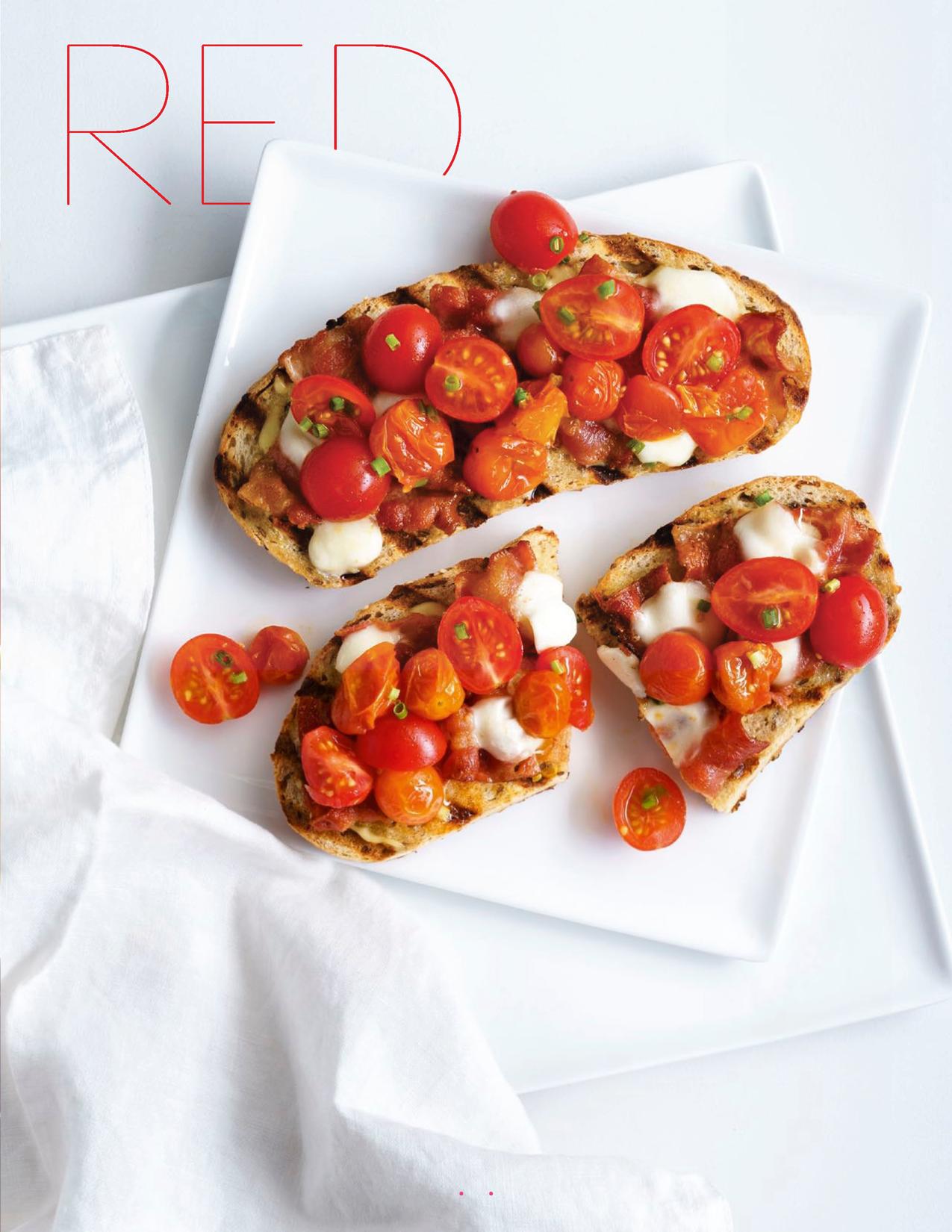
20 minute read
Cook with Color
Eating food in a myriad of colors is one of the easiest ways to make sure that only the good stuff goes in your body. Get started with these six easy dishes.
Photography by Patrick Martires Recipes and Food Styling by Melanie Jimenez Prop Styling by Paulynn Chang Afable
Advertisement
Cherry Tomato Toast
Sweet and juicy tomatoes are rich in vitamins A and
C, and are loaded with antioxidants. Get your daily dose with this light dish. Add basil leaves
Makes 2 Prep Time 20 minutes Cooking Time 20 to 30 minutes

1½ cups cherry tomatoes 1 tablespoon olive oil ½ teaspoon sea salt
FOR THE DRESSING
¼ cup chopped green onions ¼ cup white wine vinegar ³ cup olive oil sea salt and freshly ground black pepper
4 slices bacon, chopped 2 slices country bread 2 tablespoons mayonnaise ¼ cup grated mozzarella cheese green onions, to garnish
1 Preheat oven to 375°F. Line a baking sheet with parchment paper. 2 Toss half of the cherry tomatoes in olive oil on the prepared baking sheet. Sprinkle with sea salt. Roast in the preheated oven for about 20 minutes or until wrinkled and soft. Set aside. 3 Meanwhile, slice the rest of the cherry tomatoes in half. Place in a medium heatproof bowl. 4 Make the dressing: Whisk all ingredients in a small bowl. Season to taste. 5 Pour dressing over sliced tomatoes. Add roasted tomatoes to the bowl; toss to coat evenly. 6 Heat a nonstick pan over medium heat. Fry chopped bacon until crispy. 7 Toast bread until lightly browned. (You can also grill them until grill marks appear.) Spread 1 tablespoon mayonnaise on one side of each slice. Top with bacon and grated mozzarella. Toast in the oven or toaster oven for about 2 minutes or until cheese is melted. 8 Top bread with tomato mixture. Garnish with chopped green onions, if desired. Serve warm or at room temperature.
Orange Cake
Indulge in a vitamin C-loaded dessert with bright, tangy moist and buttery,

Makes 1 (8-inch) cake Prep Time 15 to 20 minutes Baking Time 20 to 25 minutes

plus more to coat pan 1 teaspoon baking powder ¼ teaspoon sea salt at room temperature 1 teaspoon vanilla extract ½ cup unsalted butter 1 cup sugar grated zest from 2 seedless navel oranges
FOR THE CANDIED ORANGE SLICES
juice from 2 navel oranges ½ cup sugar ½ cup water thin rounds using a mandoline
FOR THE GLAZE
3 tablespoons orange marmalade 2 to 3 tablespoons hot water
1 Preheat oven to 350°F. 2 Grease an 8-inch round cake pan. Line bottom with parchment shake off excess. 3 medium bowl. Repeat twice. Set aside. 4 Combine milk and vanilla in another bowl. Set aside. 5 In the bowl of an electric and orange zest on medium the sides of the bowl. 6 With the mixer on medium scraping the sides down once both eggs have been added. Beat for 1 more minute. 7 and milk mixture in 3 additions. 8 Pour batter into prepared pan and bake for 20 to 25 minutes or until a toothpick inserted in the center comes out clean. Cool unmolding cake. 9 the candied orange slices: Place all ingredients in a nonreactive saucepan over low heat. Bring to a simmer then cover. Simmer until pith is tender and 25 minutes. Transfer slices to a 10 Arrange candied orange slices on top of the cooled covering the entire cake. 11 Make the glaze: Combine marmalade and hot water in a small saucepan over mediumlow heat. Cook until smooth. add 1 more tablespoon of water. (Glaze should be used while warm.) Brush candied orange slices with the warm orange glaze. 12 chef’s knife (not a serrated knife) orange slices then push down through the cake. Clean the knife after cutting each slice.
3 tablespoons vegetable oil 3 tablespoons chopped white onions 1 tablespoon chopped garlic 2 tablespoons curry powder 1 teaspoon ground turmeric 1¼ cups coconut milk cut into 1-inch pieces 1 cup sliced potatoes (1-inch cubes) 8 to 10 curry leaves 1-inch pieces sauce (patis)
1 Heat oil a large saucepan over medium-low heat. Sauté onions and garlic until soft. Add curry powder and turmeric; cook for 3 to 4 more minutes. 2 Turn heat to medium-high. Pour in coconut milk and bring to a boil. Add vegetables and curry leaves. Lower heat to medium and simmer for 8 minutes. 3 minutes. Season to taste with Serve immediately with rice.
Fish, Cauliflower, and Potato Curry You've got all the good stuff serving has 77 percent of the recommended daily value of can help lower cholesterol and blood pressure).

ROAST GARLIC AND TOAST ALMONDS AT THE SAME TIME!
Preheat oven to 375°F. Place garlic on a piece of foil, drizzle 2 tablespoons olive oil, then fold to enclose. Place almonds on a baking tray. Place both in the oven and roast garlic for 20 to 25 minutes or until tender, and toast nuts for 6 to 8 minutes or until fragrant and lightly browned.
Kale Pesto Pasta

Green is always good. This healthy pasta dish is packed with zucchini, spinach, basil, and high-
superfood rich in a long list of nutrients.
Serves 4 Prep Time 20 to 25 minutes Cooking Time 20 to 25 minutes
1 large zucchini, julienned into 2-inch lengths (see page 75 for tip) ½ teaspoon sea salt 1½ packed cups fresh spinach leaves, sliced thinly
FOR THE KALE PESTO
2 packed cups Tuscan kale ½ packed cup fresh basil ³ cup freshly grated
Parmesan cheese toasted in a pan and cooled 6 cloves garlic, roasted and cooled ½ cup extra virgin olive oil sea salt
1 tablespoon sea salt 250 grams spaghettini 12 large leaves fresh basil, sliced thinly
1 Place zucchini in a colander and sprinkle evenly with salt. Drain for about 10 minutes. Lightly squeeze zucchini to remove excess water. 2 Toss spinach into zucchini. 3 Make the kale pesto: Process all ingredients in a food well combined. Season to taste with salt. Set aside. 4 Bring 4 cups water in a large stockpot to a boil over mediumhigh heat. Add sea salt and cook pasta according to package directions. Remove pasta from water and immediately toss in drained vegetables and kale ³ cup hot pasta water to loosen sauce. 5 Top with basil and serve hot.
Grilled Radicchio Salad
Try red leaves instead of green ones the next time you whip up a salad. Radicchio is fat- and cholesterol-free, and is rich in antioxidants.
Serves 4 Prep Time 15 to 20 minutes Cooking Time 20 to 25 minutes
FOR THE DRESSING
³ cup extra virgin olive oil ¼ cup red wine vinegar 1 to 2 tablespoons honey sea salt and pepper 1 red onion, sliced thinly
1 (650- to 700-gram) head radicchio, sliced into ½-inchthick pieces olive oil, to brush ½ cup feta cheese, crumbled

1 Make the dressing: Combine all ingredients (except onions) in a bowl; whisk until blended. Season with salt and pepper to taste. Add onions. Allow to rest for at least 20 minutes before 2 Preheat a charcoal grill, electric grill, or grill pan over medium heat. Brush both sides of each radicchio slice with olive oil. Grill for 3 to 4 minutes on each side or until tender. (Grilling time will depend on your grill; watch the radicchio carefully so it does not burn.) Immediately slice into ³-inch-thick pieces. Toss into dressing. (Don’t worry if radicchio falls apart.) Allow to cool slightly. 3 Place on a serving plate and sprinkle crumbled feta cheese on top. Serve warm or at room temperature.
6 tablespoons olive oil 4 tablespoons chopped white onions 3 tablespoons sweet
Spanish paprika 2 tablespoons chopped garlic 1 tablespoon tomato paste 60 grams frozen squid ink (available in frozen seafood section of some supermarkets) 24 fresh mussels, steamed in 2 cups water, ¼ cup cooking water reserved 3 cups cold day-old white rice ¾ cup pitted black olives, halved lengthwise sea salt and freshly ground black pepper 4 tablespoons chopped green bell peppers extra virgin olive oil, to drizzle 1 Heat olive oil in a large saucepan over medium-low heat. Sauté onions until softened. Add paprika, garlic, and tomato paste; sauté for 2 more minutes. 2 Add frozen squid ink and mash with a spoon. Add mussel cooking water. Bring to a steady simmer then stir in rice, making sure grains are coated completely. 3 Add olives; stir. Add mussels. Season to taste with sea salt and pepper. Transfer to a plate. 4 Sprinkle with chopped green bell peppers and drizzle with extra virgin olive oil. Garnish with parsley.
Squid Ink Fried Rice with Mussels

Work with the bounty of the sea to whip up a hearty rice dish loaded with mussels rich in protein and minerals.
WAYS

TO EAT
HEALTHY IN 2017
Text by Ryan Fernandez, with additional reporting by Anna Felipe Illustrations by Jon Tolentino
We’ve heard the popular saying: You are what you eat. So why not become a better version of yourself by eating smarter? Whether in the grocery, in your kitchen, or at the dining table, here are 45 helpful ideas to kick-start your project to a healthier you.
AT THE GROCERY
Shop for the best ingredients. Having a pantry full of wholesome choices is the first step to cooking and eating healthier!
1Make a grocery list
…and stick to it! Heading to the store with a list of all the necessary items makes it much easier to avoid last-minute purchases. While you’re at it, make the conscious decision not to buy unhealthy stuff. If you don’t bring in junk to your kitchen, you’re less likely to end up eating them.
2Shop with a full tummy

Even if you write a mustbuy list, if your stomach is grumbling while you’re shopping, something unnecessary is bound to end up in your cart. Avoid succumbing to last-minute cravings by eating a healthy snack before heading to the store.
3Shop the periphery and eat only real food
Skip the instant, and go for real, fresh, “whole” foods— those that haven’t been refined or processed too much. In general, the fewer steps the food takes from the farm to your table, the better its health contribution to your body. The outer edges of the grocery are typically home to fresh produce, protein, dairy, and breads. The inner aisles are where the packaged, highlyprocessed items are. The next time you shop, stick to the 80:20 rule—80 percent of the items in your cart should come from the outer aisles, 20 percent from the inner ones.
4Read nutrition labels
Analyze information like calories per serving and keep an eye out for ingredients like high fructose corn syrup and refined or enriched flour. Products that are “low fat ” and “fat free,” or have “zero trans fat ” aren’t necessarily healthier alternatives as they could be loaded with more sugar to make up for flavor.
5Switch from white to brown
Brown rice is the chewier, healthier older sibling of the Filipino staple. Take it from the Philippine Rice Research Institute: Brown rice is packed with more vitamins, minerals, and fiber than polished white rice, and can reduce the risk for type-two diabetes and heart disease. What’s more, if you’re looking to trim down, brown rice fills you up faster, signaling your brain to eat less. (Flip to page 42 for recipe ideas.)
6Stay away from HFCS
Clear your kitchen of foods with high fructose corn syrup (HFCS), a cheap sweetener used in processed foods and beverages, and avoid products with artificial sweeteners like aspartame. If you like sweets, use natural sweeteners like coconut sugar, stevia, raw honey, and agave instead. (Check out page 15 for the lowdown.)
7
GO DARK
Dark chocolate may be bitter, but it’s loaded with antioxidants that help your immune system fend off harmful elements and free radicals. Opt for a bar with at least 70 percent cocoa content.
IN THE KITCHEN
Experts agree: Cooking your own meals is always a healthier, more costefficient option to eating out. Make smarter choices in the kitchen with these tips.
8Plan ahead
Make a meal plan with seven simple recipes in rotation, one for each night of the week. It’ll take the guesswork out of daily cooking, making it easier to stick to a healthy eating habit. Plus, it will save you lots of time in the kitchen! (Get more ideas from our Weekday Cooking section on page 25.)

9Keep healthy food in sight
When you open the fridge, make sure you see the goodfor-you items first. Keep the healthy options in clear containers and the cheat treats in opaque ones. If the leftover cake is placed in the back corner, chances are, you’ll pick the juicy orange that’s right up front first.
10 Turn off the stove
Overcooking slashes nutrients from your food, so make sure to stick to a recipe’s suggested cooking time and regularly check the food you’re cooking for doneness. Remember that residual heat keeps cooking the food for a while after you remove it from the stove or oven, so let it sit for a few minutes before serving.
11 Say bye-bye to frying
If you can’t give up golden, fried-to-a-crisp foods, consider alternatives to deep-frying such as baking and stir-frying. Use coconut oil and butter instead of canola oil and margarine. You can even get an air fryer, which makes your food crisp sans the guilt.
12 Use spices instead of salt and artificial seasonings
Experiment with various herbs and spices: Cinnamon helps alleviate nausea and lowers blood sugar levels; basil and oregano have antibacterial and antiviral properties.
14
COOK WITH MIGHTY MALUNGGAY
The humble malunggay is gaining even more popularity, and with good reason: The nutrient-rich plant is a source of iron, protein, calcium, potassium, and vitamins A and C. Toss some leaves into your next salad; you can even juice the leaves or steep them in hot water to make a cup of tea.
13
GO FOR HEALTHY FAT
Not all fats are created equal, and including healthy fats is important in your diet. Oleic acid present in avocados and can have a positive impact on preventing cancer. Drizzle olive oil on your vegetables, and use peanut or coconut butter instead of cream cheese. If you’re serving Mexican food, include a lot of guacamole instead of sour cream.
15 Try turmeric
Known to give curries a vibrant yellow color, turmeric is also known as the native luyang dilaw or yellow ginger. It can help with indigestion, swelling, colds, and throat infections. Season your next meal with turmeric, or add a dash to your tea.
16 Use Omega3-rich ingredients
Omega-3 is a healthy fatty acid that helps with heart and brain health. Look for Omega-3-rich fatty fish such as salmon, tuna, and anchovies. Toss flax and chia seeds along with walnuts in your next meal.
AT THE DINNER TABLE
Try these tweaks during mealtime to start eating right! 22 Switch up your meat
Once in a while, serve grassfed beef. Each serving has almost the same amount of fat as a skinless chicken breast fillet, and contains more zinc, iron, and vitamin B12. Pasture- or naturallyraised pork and chicken are good options, too. They’re lean and tasty, and are free from chemicals and preservatives. Order these from health food stores like Down to Earth and Holy Carabao (both in Makati), or from The Green Grocer, an online seller.
23 Add broccoli to your salad and pasta
A study from the Cancer Prevention Research journal found that broccoli sprouts may actually help in thwarting the Big C, thanks to its glucoraphanin content, a compound said to have anticancer properties.
24Have fruit for dessert
Ending a meal with a serving of fruit is a smart way to satisfy your sweet tooth. Fresh fruits deliver a host of nutritional benefits that typical desserts don’t— think a boost in fiber and antioxidants. And loading up on ’em won’t lead to the dreaded sugar crash.
17Cool it with cucumber
Next time you’re stressed, turn to the humble pipino: It’s loaded with B vitamins, which can help ease feelings of anxiety. Even better, snack on cucumber sticks—they’re low in calories (a cup has only 16 calories!) and are rich in soluble fiber that can ease cravings.

18 Toast to your health
Can’t decide between wine and vodka at a party? One to two glasses of wine can have long-term benefits, including lowered risks of heart disease, type-two diabetes, and cataracts. Resveratrol (found in the skin of grapes) is known to have anti-aging properties, too.
19 Skip the soda
A can of soft drinks can contain as much as 39 grams of sugar—that’s almost eight teaspoons in every drink (the World Health Organization recommends only six per day)! Instead, try unsweetened iced tea, kombucha, or fruit juice with sparkling water if you’re looking for some fizz.
20
JUICE IT!
Do you want to eat more greens, but are tired of munching on salads? Juicing is a great way to extract nutrients without the hassle of consuming large quantities of fruits and vegetables. If you’re a juicing newbie, consider adding carrots (for clearer vision and glowing skin) or sugar beets (lowers blood pressure) to sweeten your drinks.
21 Use a red plate
Here’s a fun piece of trivia: A study from the Appetite journal found that people who eat off of a red plate tend to consume less. The research says this could be because our brains associate red with stopping.
25
CREATE THE PERFECT PLATE
Tired of counting calories? Experts from the Harvard School of Public Health recommend that half the food on your plate should be fruits and vegetables. French fries don’t count!
AT RESTAURANTS
Eating out doesn’t have to mean giving up your healthy-eating habits. These wise swaps will save the day!
26 Watch what you drink
The next time you eat out, opt for freshly brewed iced tea or fresh juice like lemonade. Many restaurants and fast-food outlets serve powdered drinks, which contain high amounts of sugar, and artificial colors and flavorings.
27 Stay away from oily food
While street food and fast food can be quick, tasty, and cheap, be mindful of eating foods cooked with reused oil. Besides being home to bacteria that eats leftover food particles, reused oil can be carcinogenic.

28 Double up on the appetizers
Don’t underestimate the starters on a menu—some of the healthiest choices are on that list! Instead of an entrée, order two appetizers to keep you satisfied—try a salad or vegetable dish, plus a protein-packed option like tuna tartare or grilled chicken skewers. Bonus: Appetizers are usually cheaper, too.
29 Look out for healthy preparations
Instead of going for something battered and fried, order a dish that’s baked, steamed, grilled, poached, or blackened. These cooking methods deliver different flavor profiles that also hit the spot! 30 Speak up Don’t be shy to ask your waiter for other options. They will often be willing to assist you. Here are some tweaks to try: If an item is fried, ask to have it grilled; if it comes with french fries, go for a baked potato or a side of vegetables instead; swap out the coleslaw for a salad or steamed veggies; ask to have the dressing or sauce served on the side.
31 Keep the cream to a minimum
Dishes on the menu with words like creamy, breaded, crisp, sauced, and stuffed are likely loaded with hidden fats. Watch out for their synonyms, too: Buttery, sautéed, pan-fried, cheese sauce, scalloped, au gratin, au lait, à la mode, and au fromage (with milk, ice cream, or cheese).
32 Be smart about sweet treats
You can always have a scoop of sorbet, a serving of yogurt, or a piece of dark chocolate when you get home— definitely more waistline- and wallet-friendly! Ending your meal with coffee? Go black or use natural sweeteners, and skip the whipped cream or ice cream topping.
33
SAY YES TO SUSHI
tea—all nutrition
34 Split with a friend
Restaurant portions keep getting bigger and bigger. A better, more cost-effective way to enjoy your meal? Share a dish or two with a friend. This way, you get to try more offerings without feeling stuffed and without all the extra calories.
35
BE A CONSCIOUS CARNIVORE
Meat is a great source of protein—our body’s building block—but and poultry instead of beef and pork. meat consumed daily can lead to strokes, and various types of International Agency eating processed meat risk of colorectal and gastric cancers.
ON A DAILY BASIS
Be consistent with your good habits, and you’ll be rewarded with great results! 42 Make fiber your friend
A fiber-rich diet has many benefits, ranging from weight loss to a lowered risk of diabetes to regular bowel movement. By loading up on vegetables, you can ensure your body receives a steady supply of fiber.
43 Choose chia
It’s no coincidence that chia is also the ancient Mayan word for “strength.” The tiny seeds are packed with protein, trace minerals, and Omega-3, among other nutrients, and help improve metabolism and promote weight loss. Add chia to your next shake, oatmeal, and salad.
36 Break the fast
Don’t let the morning rush overwhelm you; eat breakfast! Skipping the first meal of the day can greatly affect your ability to eat responsibly. Giving in to cravings leads to stockpiling calories throughout the day.

37 Savor the flavor
Savoring your meal by eating slowly can have health benefits, including better nutrient absorption. Eating slowly also gives your brain enough time to realize that you're full, preventing you from overeating. Eat small forkfuls, and chew until your food has lost its initial flavor and texture.
38 Choose your carbs wisely
You might be skipping rice, but potatoes, grains, and sweets also add up to your carb intake. Opt for nonstarchy choices such as leafy greens and nuts, which contain fiber that contribute to digestive health and weight loss.
39 Look to the food pyramid
Base your diet on the revamped food pyramid. Vegetables and fruits have replaced carbohydrates on the bottom as the largest portion of our daily diet. At the top, you can indulge in healthy fats such as extra virgin olive oil.
40 Color your diet
The World Health Organization recommends nine to 10 servings of fruits and vegetables daily. Prioritize a wide assortment with every meal. The more colorful your plate, the better. (Check out our rainbow of recipes on page 52.)
41 Trust your gut
Living inside your digestive tract are millions of good bacteria, which determine your ability to absorb nutrients. Fermented foods such as kimchi, yogurt, kefir, tempeh, and miso are probiotics, which ensure good gut health. Even better, they can lower insulin resistance while accelerating metabolism.
44
POWER UP WITH PROTEIN-RICH ALTERNATIVES
Bulk up with a wider variety of protein sources. Aside yogurt. They are rich in other a symphony-like combined approach to better health. our spiced lentils and rice with caramelized onions on page 23.)
45
NIBBLE ON NUTS
Ditch the chips and snack on nuts—they’re great additions to a heart-healthy diet. There’s a strong connection between regularly of bad cholesterol and preventing plaque formation in arteries.










